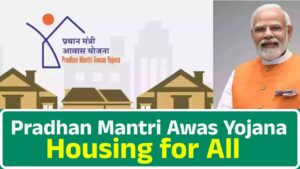Pradhan Mantri Awas Yojana(PMAY)
Overview
The Pradhan Mantri Awas Yojana (PMAY) is a flagship initiative launched by the Government of India in 2015, aimed at achieving “Housing for All” by 2022. It seeks to provide affordable, pucca (permanent) housing to all eligible urban and rural poor, particularly women, economically weaker sections (EWS), low-income groups (LIG), and middle-income groups (MIG). The scheme has two major components:
- PMAY–Urban (PMAY-U)
- PMAY–Gramin (PMAY-G)

Objectives of PMAY
The main goals of PMAY include:
- Eliminating homelessness
- Providing houses with basic amenities like water, electricity, sanitation
- Promoting women ownership
- Using eco-friendly and disaster-resilient technologies
- Integrating slum rehabilitation with formal housing
Verticals of PMAY
The scheme operates through four implementation verticals:
- In-Situ Slum Redevelopment (ISSR) – Redeveloping slums using land as a resource
- Credit Linked Subsidy Scheme (CLSS) – Interest subsidy on home loans
- Affordable Housing in Partnership (AHP) – Partnership with public/private developers
- Beneficiary-Led Construction (BLC) – Assistance to individuals for constructing or enhancing homes
PMAY–Urban (PMAY-U)
Target Group
- Urban poor, especially slum dwellers
- Includes EWS (income ≤ ₹3 lakh), LIG (₹3–6 lakh), and MIG (₹6–18 lakh)
Key Features
- Mandatory women ownership
- Preference to disabled persons, senior citizens, transgender persons
- Geo-tagging for transparency
- Convergence with schemes like Smart Cities, AMRUT, and Swachh Bharat
Achievements
- Over 1.18 crore houses sanctioned
- Over 80 lakh houses completed
- Emphasis on slum-free cities
PMAY–Gramin (PMAY-G)
Target Group
- Rural families without a pucca house
- Prioritizes SC/ST, minorities, widows, disabled persons
Key Features
- Replaced Indira Awaas Yojana
- Financial assistance:
- ₹1.2 lakh for plain areas
- ₹1.3 lakh for hilly or difficult areas
- Houses registered in the name of women
- Use of Socio-Economic Caste Census (SECC) for identifying beneficiaries
- DBT (Direct Benefit Transfer) to avoid corruption
Achievements
- Over 2 crore houses built
- Improved access to toilets, drinking water, LPG, and electricity
Credit Linked Subsidy Scheme (CLSS)
This vertical offers interest subsidy on housing loans:
- EWS/LIG: 6.5% on loans up to ₹6 lakh
- MIG-I: 4% on loans up to ₹9 lakh
- MIG-II: 3% on loans up to ₹12 lakh
CLSS is implemented through lending institutions, with subsidies credited directly to the borrower’s loan account, thereby reducing EMI burdens.
Technology and Innovation in PMAY
- AwaasSoft and AwaasApp monitor PMAY-G projects
- MIS portals and geo-tagging for real-time tracking
- Prefabricated construction methods for speed and cost-effectiveness
- Global Housing Technology Challenge (GHTC) to bring innovation from around the world
Role of Stakeholders
Central Government
- Provides major portion of funding
- Sets policy framework and guidelines
State Governments and Urban Local Bodies (ULBs)
- Prepare Housing for All Plans of Action (HFAPoAs)
- Implement the scheme on the ground
- Manage land, approvals, and partnerships
Financial Institutions
- Implement CLSS
- Partner with Central Nodal Agencies like HUDCO, NHB, and SBI
Monitoring Mechanism
PMAY includes robust monitoring:
- Third-party evaluations
- Real-time dashboards
- Social audits
- Field inspections
- Regular updates published by the Ministry of Housing and Urban Affairs (MoHUA)
Challenges and Issues
Despite its success, PMAY faces several issues:
- Land availability, especially in urban areas
- Delays in approvals and construction
- Inclusion of ineligible beneficiaries (ghost beneficiaries)
- Variation in implementation efficiency across states
- Lack of awareness among rural households
Social and Economic Impact
- Empowered women through property ownership
- Boosted employment in construction sector
- Improved health and sanitation
- Increased school attendance among children due to better living conditions
- Contributed to the rural economy
Recent Developments (2023–2025)
- Extension of PMAY-U till December 2024
- Incorporation of 3D printing technologies in housing
- Increased focus on Tier 2 and Tier 3 cities
- Added emphasis on migrant workers and rental housing
- Integration with PM-KUSUM for solar rooftops
- Enhanced financial norms for special category states
Success Stories
Sita Devi (Urban, Lucknow)
Built a home under PMAY-U’s BLC scheme; her children now have a stable learning environment.
Bhupendra (Rural, Chhattisgarh)
Upgraded from a mud hut to a pucca house with LPG, water, and electricity under PMAY-G.
Criticisms
- Incomplete houses in some areas
- Delays due to red tape and contractor inefficiency
- Complaints about quality of construction
- Need for better targeting and verification systems
Future Outlook
Looking ahead, the government plans to:
- Cover remaining housing-deficient households
- Promote eco-friendly self-construction models
- Develop rental housing policies
- Ensure inclusive housing for migrant workers, disabled, and minorities
- Strengthen urban planning around affordable housing
Conclusion
Pradhan Mantri Awas Yojana has emerged as a transformative mission that blends social equity, economic empowerment, and infrastructure development. With millions of homes already delivered, it has dramatically improved lives, especially for rural families and women. While challenges remain, its scalable and inclusive design offers a strong foundation for sustainable housing development in India.
